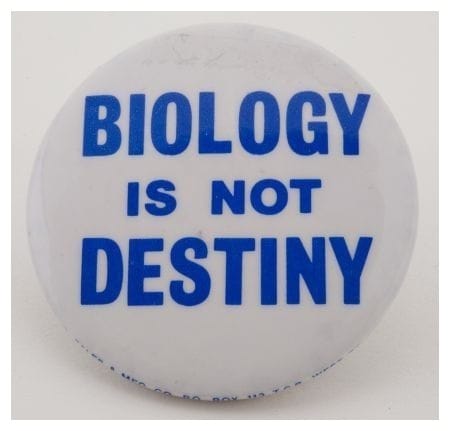The WHRC Declaration, Explained (part 1)
I was originally going to make this a multi-part series going through the WHRC declaration in deep detail from start to finish. However…
I was originally going to make this a multi-part series going through the WHRC declaration in deep detail from start to finish. However since writing it, legal scholar and International Human Rights Law academic Sandra Duffy has written a much more rigorous and scholarly analysis. I really recommend going straight to that instead. I’m an activist who can read technical language competently but I’m not a lawyer.
I am incredibly grateful for the considered effort that went into Duffy’s analysis, which largely concords with my own view of the Women’s Declaration, and is more forthright than I was, because I was trying to stay cautious of the limits of my own knowledge.
The WHRC Declaration on Women’s Sex-Based Rights (“the Declaration”) is a sprawling commitment asserting a collection of claims, concerns, and affirmations, based around the international human rights law framework of the United Nations 1979 Convention on the Elimination of All Forms of Discrimination against Women (“CEDAW”). The original Declaration format as published in 2019 (A5_Declaration_Booklet.pdf) was 32 pages long, and the amended format now published since 2020 (DECLARATION_-_FINAL_VERSION_AMENDED.pdf) is 20 pages long, although it does not appear that the text has changed substantively between versions.
The Women’s Declaration is unambiguously a document for the abolition of trans people’s civil rights. This has become controversial because it is the leading definition of the so-called “sex-based rights” and has become a core manifesto of the Gender Critical movement. It was written by Maureen O’Hara, Sheila Jeffreys (who has openly described trans women as “parasites”, and regularly as perverts and various other epithets), and Heather Brunskell-Evans (who is a major backer of antisemitic theories about the funding behind Transgenderism).
I’ll be working on laying out some breakdowns of it section by section as I find time for it.
The Introduction
The opening move of the Declaration is (p.1) to cite Article 1 of CEDAW, which defines discrimination against women as any distinction exclusion or restriction based on sex which has the effect of impairing women’s human rights or fundamental freedoms in any field, and citing that in the UN Women glossary, sex is defined as the physical and biological characteristics that distinguish males and females. It then cites the CEDAW obligations under Article 2 on states to “take all appropriate measures to modify or abolish laws… which constitute discrimination against women”.
This sets the ground to then assert (without citation) that “stereotyped sex roles of men and women are a fundamental aspect of women’s inequality and must be eliminated”.
Given the context of this document being written in reaction to the gradual mainstreaming of trans civil rights to gender recognition it’s hard not to interpret this as building a case towards arguing that transgender life and the civil rights is fulfilling stereotypes and ought to be eliminated. As we shall see further on this plays out.
The Declaration expands on this drawing on Article 5 of CEDAW which obliges states to “modify the social and cultural patterns of conduct of men and women, with a view to achieving the elimination of prejudices and customary and all other practices which are based on the idea of the inferiority or the superiority of either of the sexes or on stereotyped roles for men and women.”
Again, in the CEDAW, this is clearly about eliminating sexist stereotypes which hamper or harm the livelihood, inclusion and rights of women in patriarchal society. But the citation here is being made in the context of reaction to trans life. Bearing in mind the assumption made in the Declaration that transition is furthering the proliferation of such prejudices and practices based on stereotyped roles for men and women, this obligation should be understood to be being cited here, not just as an obligation to encourage men to abandon patriarchal elitism and women to be less subservient, but as an obligation to correct expressions of transgender gender identity (which the authors of the document view as tied up in gender stereotyping).
On p.2, this attitude towards transgender people’s gender identities as a form of stereotyped role preservation is immediately demonstrated, saying:
Recent changes replacing references to the category of sex, which is biological, with the language of ’gender’, which refers to stereotyped sex roles, in United Nations documents, strategies, and actions, has led to confusion which ultimately risks undermining the protection of women’s human rights.
The confusion between sex and ‘gender’ has contributed to the increasing acceptability of the idea of innate ‘gender identities’, and has led to the promotion of a right to the protection of such ‘identities’, ultimately leading to the erosion of the gains made by women over decades….
…the concept of ‘gender identity’ makes socially constructed stereotypes, which organize and maintain women’s inequality, into essential and innate conditions, thereby undermining women’s sex-based rights.
Unambiguously this document is making a quasi legal case against the protection of transgender people’s civil rights (typically articulated as the protection of “gender identity” although this is widely, such as in the UK, protected in the form of protection for “gender reassignment”, based on undergoing some form of transition). As above, this is based on an argument that trans rights are rooted in maintaining stereotyped sex roles (despite the fact that every trans person who transitions has by definition rejected the role assigned to them according to their sex under the UN definition cited by the Declaration immediately above!).
As an example of this “stereotype” protection is the Declaration cites Yogyakarta Principles (2007) regarding personal experience of gender, modification of bodily appearance or other forms of gender expression. While accepting that individuals have a right to dress as they please, the Declaration asserts:
the concept of ‘gender identity’ has enabled men who claim a female ‘gender identity’ to assert, in law, policies, and practice, that they are members of the category of women, which is a category based upon sex.
To make this more concrete, in the UK where the WHRC and the authors are based, an example for this claim would be reasonably interpreted as referring to the Gender Recognition Act 2004 which was brought into place following Goodwin v United Kingdom 2002 whereby the European Court of Human Rights ruled that it was against trans people’s human rights not to recognise a the change of legal sex of a transsexual). The case being made here is that laws like the GRA are in violation of women’s rights to freedom from discrimination because trans women (who the Declaration calls “men”, throughout) are recognised as women. We can be clear that the Declaration when it refers to “men” is invariably talking about trans women because they are talking throughout about people who are born legally male who transition (in law and rights) to being legally female.
Without concrete examples to make explicit whether they mean socially or legally or in any other context that might enable readers to understand what impact they’re raising “concerns” about, they further assert that
The concept of ‘gender identity’ is used to challenge individuals’ rights to define their sexual orientation on the basis of sex rather than ‘gender identity’, enabling men who claim a female ‘gender identity’ to seek to be included in the category of lesbian, which is a category based upon sex. This undermines the sex-based rights of lesbians, and is a form of discrimination against women.
Obviously anyone is free to define their own sexual orientation in any way they please, and the protections cited elsewhere in the introduction which explicitly focus on the rights of lesbians to select their own partners according to their free will are important. However, it seems unclear that any law anywhere in the world exists which specifically uses Gender Identity to contravene this right. This is the raising of a concern that trans women are a threat to lesbians without any apparent threat actually existing.
The Declaration goes on to raise a similar alarm about “motherhood”
Some men who claim a female ‘gender identity’ seek to be included in the legal category of mother. The CEDAW emphasises maternal rights and the “social significance of maternity’’. Maternal rights and services are based on women’s unique capacity to gestate and give birth to children. The inclusion of men who claim a female ‘gender identity’ within the legal category of mother erodes the social significance of maternity, and undermines the maternal rights for which the CEDAW provides.
Again, what we see here carries no concrete example of harm to women, not a law anywhere in the world whereby Gender Identity has been allowed to erase or abrogate women’s maternity rights, resulting in any form of discrimination. There are trans women who refer to ourselves as mothers, much as there are those cis women who also dare to refer to themselves as mothers by adoption without gestation taking place. This is commonplace freedom of expression and language. Why ought the state, or a body like the UN intervene against individual diversity of expression? What does it take away from those mothers who have gestated and given birth? I really doubt it affects them.
Moving on, there is a detour into discussion of surrogate motherhood and the commodification of women’s reproductive capacity. It is claimed through this that this “underpins medical research which is aimed at enabling men to gestate and give birth to children.”
It’s really hard to see how!! Nonetheless, we have a summing up claiming that recognition of trans women threatens to remove all meaning from the categories of woman, lesbian and mother.
There’s a further, uncited and inconcrete claim that organisations, state agencies, public bodies and private organisations which promote ‘gender identity’ are compelling women and girls against their rights to define themselves and organise based on common interests as a sex, and challenging the rights of lesbians to assemble or organise based on common sexual orientation. Again, without clear evidence it’s impossible to contextualise any of this. For instance, is this talking about trans people bringing discrimination cases against public services and accommodations which have sex segregated toilets for having policies which force us to out or humiliate ourselves, or is this about social clubs, societies, or other organisations where people have a legitimate free association right to discriminate if they so wish? Impossible to say.
We then have a claim that trans women are being allowed to access affirmative action programmes as women, and therefore taking places which were created for the advancement of equality between men and women. This is followed with a similar point about trans women’s participation in women’s sports creating competitive disadvantage. I’ll save debating that one for the purposes of this explainer, but suffice to say that trans women are very few in number and so far there has not been a single trans woman excelling at the top level of elite sport. The closest so far was powerlifter Laurel Hubbard, who qualified for the 2020 Olympics before failing to complete her lifts (which were in any case short of the 1st place lifter). She also previously wrecked a joint trying to lift in the 2017 Commonwealth Games. Statistically, per-capita, trans women significantly underperform in elite sports, with 0 gold medalists out of tens of thousands of Olympian women since the IOC published protocols allowing trans women to participate in 2003.
Following this up is a statement about the UN Declaration on the Elimination of Violence Against Women (UNDEVAW), which explicitly states that violence against women is a manifestation of historical inequality between men and women, by which women are forced into a subordinate position. The WHRC Declaration follows this up by asserting, without citation again, that
This domination and discrimination is based on sex and not on ‘gender identity’.
This is a statement of opposition to the increasing consensus around a wider pattern of “gender based violence” which is defined by the Council of Europe thusly:
Gender-based violence refers to any type of harm that is perpetrated against a person or group of people because of their factual or perceived sex, gender, sexual orientation and/or gender identity.
The framing of Gender-based violence does not even slightly erase sex-based violence. Instead it is an expansive framework which understands that misogynist, homophobic and transphobic violence are an interrelated system of violent domination organised around reinforcing stereotyped sex roles. It’s difficult to see this attack by the Declaration on the GBV framework as anything other than unpicking the last few decades of development in feminist understanding and coalition building between LGB, Trans and Women’s Rights activists to build a united front against patriarchal violence.
The relevance here in the Declaration is so that they can make a claim that the introduction of the “Gender” frame has allowed trans women (under ‘gender identity’ rights) to claim access to single sex victim support services and spaces, as both services users and service providers. In doing so the Declaration is making a clear assumption that trans women do not need these services as survivors and after transition do not experience heightened levels of domestic and sexual violence as a direct result of moving through the world as women. This is contrary to the 2015 US National Transgender Survey (the largest of its kind in existence) which showed rates of experiencing sexual violence as high as 50%.
The next concern raised by the Declaration is around the obligation to collect “sex-disaggregated data”, and the issues with that when trans women move through life and society as women. While this data collection right makes sense in the context of systematic biases towards collection of data based on a male “norm”, given cisgender women are 51% of the population at present, and trans women are roughly 0.1%, it is hard to imagine many circumstances where any ambiguity trans women introduce by crossing categories within the dataset would be anything detectable within the confidence bounds of most statistical analyses.
The Declaration then goes on to claim that gender identity is used to reassign children who do not conform to sex stereotypes or are diagnosed with dysphoria, with references to high risk medical interventions, which the Declaration claims are used on children who are not developmentally competent to give informed consent. A more accurate way of describing this (given that there is nowhere I am aware of yet where legal reassignment is a possibility for trans children), is that the growing understanding and consensus around gender identity means that trans children are increasingly being given agency in age appropriate ways to express themselves as trans children, as well as controlled and age appropriate support to access medical treatments with a now decades long case history of thousands of trans children supported to transition through medicine with emerging refined consensus around protocols and evidence to show at what stage children are likely to be able to make competent decisions with the appropriate information provided. Additionally we have an emerging historical picture of transgender children pre-dating the history of medically supported transitions.
Summary
First of all, the introduction lays the groundwork for claiming that trans rights in general constitute a form of discrimination against women and that laws enforcing trans civil rights to transition and be recognised as our transitioned/acquired sex (or gender, whatever) should be abolished or modified so that they no longer serve this function.
It defines “gender identity” in terms of upholding stereotypes and thus being trans at all is by implication a form of discriminatory behaviour (which is lays groundwork for claiming a CEDAW obligation for states to intervene and modify behaviour around — i.e. undertake conversion therapy or otherwise render transness illegal in some way).
It then discusses surrogacy as a gateway to technologies which might enable trans women to gestate and give birth and argues that this is discriminatory against women.
It argues that trans women identifying as mothers, lesbians or as women in fact is a form of discrimination and alleges without concrete examples to take issue with that this is affecting all three categories. A particular focus here is around “freedom of association” and “freedom of belief”, but the lack of concrete evidence makes these hard to evaluate as claims.
It argues that trans women are taking over protected areas preserved for women (and therefore holding cis women back from securing equality), such as sports and affirmative action programmes. Evidence that this problem is widespread or a significant problem at all remains to be seen as there are still no trans women Olympian medallists some 18 years into securing the rights to compete in elite sport.
It then attacks the framework of Gender Based Violence and erases the sadly very real research indicating that trans women face considerable amounts of sexual violence as a result of moving through lives as women.
A claim is outlined about the problems of sex-disaggregation of data and women’s rights, but this doesn’t bear up under the slightest statistical scrutiny.
And last of all it attacks trans childrens’ rights to transition related healthcare (while delegitimising the entire idea of a transgender child — something one of the authors of the document had also done at greater length in her book Inventing the Transgender Child).
That’s about it for now, I’ll carry on further with the Declaration advocating for banning trans women from women’s toilets (reversing our existing rights in many countries such as the UK) in a future installment.


